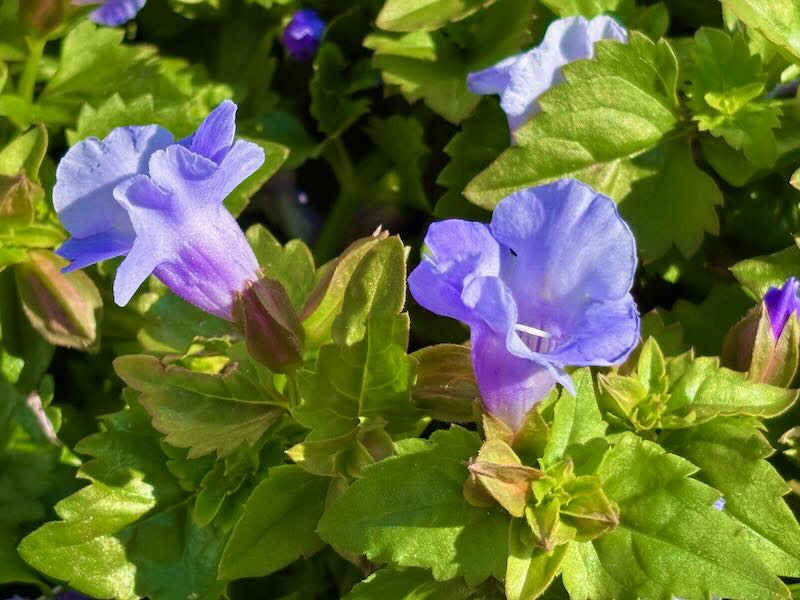Linderniaceae: A Comprehensive Overview of the False Pimpernel Family
The Linderniaceae family, commonly known as the False Pimpernel family, is a fascinating group of flowering plants within the order Lamiales. Once grouped within the broader Scrophulariaceae, these plants now stand on their own thanks to molecular studies that clarified their evolutionary relationships. With about 10 genera and roughly 265 species worldwide, Linderniaceae enjoys a cosmopolitan distribution, especially in tropical and subtropical regions. Gardeners encounter its members in wetlands, aquariums, hanging baskets, and borders, highlighting the family’s incredible versatility and horticultural value.
Background and Taxonomy of Linderniaceae
The modern story of Linderniaceae begins with taxonomic reshuffling. For centuries, botanists placed many of its species within Scrophulariaceae, a massive family that once served as a catchall for bilabiate-flowered herbs. With the advent of molecular phylogenetics in the late twentieth century, researchers discovered that Scrophulariaceae as then defined was not monophyletic. DNA sequencing revealed that a distinct clade—later recognized as Linderniaceae—deserved family rank. This separation was formalized in the early 2000s and reinforced by the Angiosperm Phylogeny Group (APG III) in 2009.
The family name comes from the genus Lindernia, itself honoring Franz Balthasar von Lindern, an Alsatian botanist who lived from 1682 to 1755. Today, Linderniaceae represents a compact but morphologically diverse group of plants, ranging from creeping aquatics to bushy ornamentals.
Habitat and Global Distribution
Linderniaceae species thrive in moist environments and often take advantage of disturbed soils. Their adaptability explains their wide distribution across multiple continents.
- Wetlands and riverbanks: Many Lindernia species inhabit muddy soils along rivers, streams, and lakeshores, where seasonal flooding creates open, competition-free habitats.
- Rice paddies and agricultural fields: Some species, particularly Lindernia procumbens, have adapted so well to flooded fields that they are common weeds in Asian rice paddies.
- Tropical forests and grasslands: Other species grow in the damp understories of tropical forests, where filtered light and moist soils create ideal conditions.
- Aquatic environments: Genera such as Micranthemum grow fully submerged, which has made them popular in aquarium culture worldwide.
This family’s global reach underscores its ecological flexibility. From South America to Asia, from Africa to Europe, Linderniaceae members adapt to both natural wetlands and human-modified habitats.
Distinguishing Features of Linderniaceae
While varied in form, Linderniaceae members share a suite of traits that allow botanists and gardeners to recognize them.
Vegetative features
Most species are annual or perennial herbs. Stems may be erect, creeping, or sprawling, and many are distinctly four-angled in cross section. Leaves are simple and typically opposite, with margins entire or finely toothed. In some creeping species, the leaves root at the nodes, allowing mats of foliage to spread across damp soil or water surfaces.
Reproductive features
Flowers are bisexual and bilaterally symmetrical, usually borne singly in the leaf axils or grouped in racemes. The corolla is bilabiate, with an enlarged lower lip that provides a landing platform for pollinators. This two-lipped design is a hallmark of the Lamiales order, but Linderniaceae adds its own twists.
A key diagnostic trait lies in the stamens. Most species have four stamens, though sometimes only two are fertile. The lower stamens are often curved, bent, or club-shaped, a feature known as geniculate filaments. This unusual stamen form helps distinguish Linderniaceae from related families.
The stigma is bilobed and often sensitive, responding to touch in ways that enhance pollination efficiency. Fruits are capsules that split open to release numerous tiny seeds, enabling wide dispersal in wet habitats.
Absence of iridoids
Chemically, Linderniaceae differs from many Lamiales relatives by lacking iridoid compounds. This absence was an important clue in clarifying its separation from Scrophulariaceae.
Growth Habits and Plant Forms
The growth forms in Linderniaceae range widely, reflecting adaptation to diverse habitats.
- Creeping aquatics: Micranthemum species form delicate mats underwater, making them favorites in aquascaping.
- Weedy herbs: Lindernia dubia and Lindernia procumbens grow in muddy fields and disturbed soils, spreading quickly through seed.
- Bushy ornamentals: Torenia fournieri, known as wishbone flower, produces compact mounds covered in bright blossoms, ideal for containers and bedding.
Most plants remain small, under 50 cm (20 in) tall, though trailing stems can spread wider in hanging baskets or creeping mats. Their modest size and fast growth rate make them easy to cultivate and integrate into garden or aquarium settings.
Flowering Season of Linderniaceae
Flowering times vary depending on habitat and species. In tropical climates, flowering often extends throughout the rainy season and continues into drier months where moisture persists. Torenia fournieri, widely grown in gardens, blooms from spring through autumn, providing nearly continuous color in warm climates. Lindernia dubia flowers in summer and autumn across North America, while Micranthemum species bloom sporadically underwater, often unnoticed except by close observers.
Notable Genera and Species
Lindernia
The type genus anchors the family and includes over 100 species. These small herbs typically grow in wet or muddy habitats.
- Lindernia dubia, sometimes called yellowseed false pimpernel, is native to the Americas but now widespread globally. It thrives in wetlands, ditches, and pond margins. Its small lavender flowers and weedy habit make it a common sight in rice fields and drainage ditches.
- Lindernia procumbens is valued in traditional Chinese medicine and widely known as a paddy weed. Farmers have long battled its persistence in flooded fields, but herbalists prize it for treating fevers and skin ailments.
Torenia
This genus has captured gardeners’ attention with its bright, wishbone-shaped flowers. Several species are cultivated as bedding plants.
- Torenia fournieri, the wishbone flower, produces blooms in purple, blue, pink, and white. It thrives in warm, humid climates, flowering prolifically from spring to fall. Gardeners often use it in hanging baskets, borders, and shaded beds.
- Cultivars of Torenia extend its color range and improve disease resistance, making it a versatile annual in tropical and subtropical landscapes.
Micranthemum
Famous in aquascaping, Micranthemum species grow submerged, with tiny round leaves forming carpets across aquarium substrates.
- Micranthemum umbrosum, also called baby tears, is one of the most popular aquarium plants. It forms bright green mats under water, providing shelter for fish and a lush aesthetic for aquarists.
Vandellia
The genus Vandellia has undergone taxonomic revisions based on molecular data. Some species hold cultural importance.
- Vandellia micrantha is reportedly eaten in parts of Laos, where its leaves are cooked as a bitter green. While not widely cultivated, it illustrates the edible potential of the family.
Ecological Roles and Adaptations
Linderniaceae plants contribute significantly to ecosystems where they grow. Their flowers attract pollinators such as bees, butterflies, and even hummingbirds in the case of Torenia. Their creeping or aquatic growth forms stabilize soils and sediments, especially along riverbanks and wetlands.
Many species adapt to disturbed habitats, quickly colonizing muddy soils after floods or tillage. This ecological niche allows them to persist in agricultural systems, sometimes as weeds, sometimes as useful groundcovers. Their bilabiate flowers and sensitive stigmas enhance pollination efficiency, ensuring reproduction in crowded or unpredictable environments.
Cultural and Horticultural Uses
Gardeners and aquarists alike value Linderniaceae members.
- Ornamentals: Torenia fournieri and its cultivars are prized for vibrant, continuous blooms in shaded or partially sunny beds. Their compact habit and colorful flowers make them perfect for borders, containers, and hanging baskets.
- Aquarium plants: Micranthemum umbrosum and related species dominate aquascaping, forming lush carpets that provide both beauty and habitat for small aquatic life.
- Medicinal uses: Several Lindernia species have long histories in folk medicine. Herbalists in Asia use them to treat fever, dysentery, and skin conditions. Research continues into their alkaloids and potential anti-inflammatory properties.
- Edible species: Though not widespread, species such as Vandellia micrantha have been consumed locally, usually cooked to soften their bitterness.
For gardeners, the combination of ornamentals and aquatics makes Linderniaceae a family of multiple niches—useful indoors, outdoors, in soil, or under water.
Distinguishing Facts About Linderniaceae
- Bilabiate flowers: Two-lipped corollas with enlarged lower lips are common, giving the flowers their distinctive form.
- Geniculate filaments: Curved or club-shaped filaments on the lower stamens are diagnostic.
- Sensitive stigmas: Bilobed stigmas that respond to touch improve pollination success.
- Habitat preference: A strong affinity for moist, wet, or semi-aquatic habitats unites the family.
- Absence of iridoids: Unlike many Lamiales, Linderniaceae lacks these compounds, a chemical clue that supported its taxonomic separation.
Conclusion
The Linderniaceae family may not be as famous as roses or orchids, but its diversity and utility make it a fascinating group for gardeners and plant enthusiasts. From the cheerful wishbone flowers of Torenia fournieri to the lush underwater carpets of Micranthemum umbrosum, and from medicinal Lindernia species to edible Vandellia, this family spans ecosystems, continents, and human uses. Its evolutionary story—once hidden in the shadows of Scrophulariaceae—now stands clear as a distinct, coherent lineage.
For gardeners, aquarists, and botanists, Linderniaceae offers a family that thrives in water and soil, under glass or under sun, with flowers and foliage that bridge utility and beauty. Understanding its traits, habitats, and uses deepens our appreciation of how a relatively small family can play such a wide role in both ecosystems and gardens.
The Genera in the Linderniaceae family include:
Linderniella
Micranthemum
Picria
Pierranthus
Schizotorenia
Scolophyllum
Stemodiopsis
Vandellia
Yamazakia


